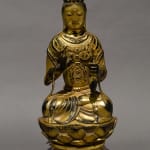Ming Gilt-Bronze Figure of Maitreya, 15th Century CE - 17th Century CE
Gilt-Bronze
10
CB.3315
Further images
This is a stunning gilt-bronze statue of a seated Maitreya. Seated in dhyanasana posture atop a lotus flower with a triple base, he gazes down with a solemn facial expression....
This is a stunning gilt-bronze statue of a seated Maitreya. Seated in dhyanasana posture atop a lotus flower with a triple base, he gazes down with a solemn facial expression. The stupa on his crown and the water flask held in his left hand are exclusive iconographic features which identify the figure as Maitreya. Dressed in jewelled bodhisattva outlook, his craftily decorated keyura rests atop his elegant clothing. With auspicious folds on his neck, his right hand forms the abhaya mudra, welcoming the beholder in reassurance, dispelling any fear and offering protection. The figure has a conservative style of clothing, covering up most part of the body barely showing any skin. Together with the form and shape of the lotus pedestal, as well as the patina, it is reasonable to date the piece to Ming Dynasty. The base seal remains intact.
Maitreya is the future Buddha, who is to succeed the Buddha Shakyamuni in the next Buddhist cosmological era. Since Maitreya would not assume Buddhahood until then, he retains his jewelled bodhisattva outlook. Before Avalokitesvara’s (Guanyin) sudden boom of fame and popularity in Tang and Song Dynasty, Maitreya was the most important bodhisattva among Chinese Buddhists particularly during the Northern Dynasties.
This is an intricating piece which pays homage to early Northern Dynasties style. The figure’s crown is reminiscent of the ones in Northern Dynasties Buddhist cave art (one example is Museum of Fine Arts Boston, Item 13.2804). Likewise, this form of Maitreya holding a water flask resembles the earliest form of Maitreya in China, before the water flask was incorporated by later forms of both Chinese Buddhist and Taoist Avalokitesvara, such as Water-Moon and Vase-Wielding Guanyin.
Maitreya is the future Buddha, who is to succeed the Buddha Shakyamuni in the next Buddhist cosmological era. Since Maitreya would not assume Buddhahood until then, he retains his jewelled bodhisattva outlook. Before Avalokitesvara’s (Guanyin) sudden boom of fame and popularity in Tang and Song Dynasty, Maitreya was the most important bodhisattva among Chinese Buddhists particularly during the Northern Dynasties.
This is an intricating piece which pays homage to early Northern Dynasties style. The figure’s crown is reminiscent of the ones in Northern Dynasties Buddhist cave art (one example is Museum of Fine Arts Boston, Item 13.2804). Likewise, this form of Maitreya holding a water flask resembles the earliest form of Maitreya in China, before the water flask was incorporated by later forms of both Chinese Buddhist and Taoist Avalokitesvara, such as Water-Moon and Vase-Wielding Guanyin.





